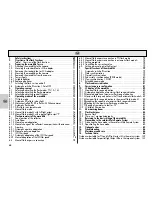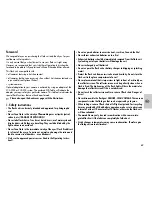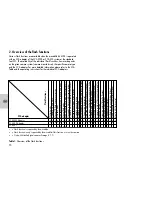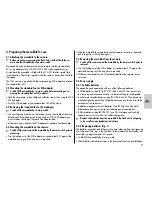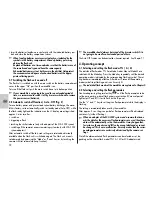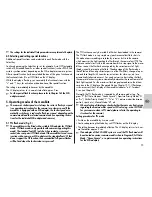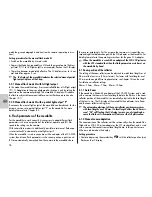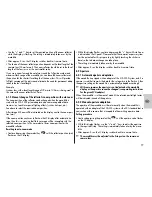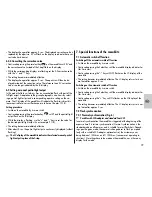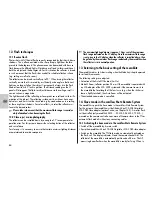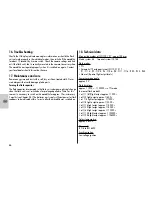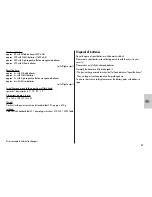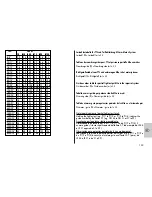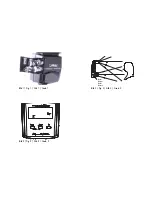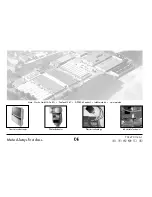
The extended zoom mode is only possible in the “Auto Zoom” mode with a
focal length setting as of 35 mm (35 mm format). Since the start position of
the zoom reflector is 28 mm, a focal length of less than 35 mm will cause
“28” mm to flash on the LC display, thereby warning the user that the re-
quired 24 mm reflector position for extended zoom mode cannot be set.
Shots with a 28 mm to 35 mm focal length of the lens will be correctly
illuminated right out to the image corners by the mecablitz also in the
extended zoom mode.
Switching on the extended zoom mode
• Continue depressing the Select key until “Ex” is indicated on the LC display.
• Continue depressing the “+” key until “On” flashes on the LC display.
• The setting becomes instantly effective. The LC display is switched back to
its normal state after approx. 5 sec.
After the setting procedure, the “Ex” symbol for extended zoom mode will
continue to be indicated on the mecablitz LC display.
Please note that the wider illumination coverage in extended zoom
mode results in a diminished maximum flash range.
Switching off the extended zoom mode
• Continue depressing the Select key until “Ex” is indicated on the LC display.
• Continue depressing the “-” key until “OFF” flashes on the LC display.
• The setting becomes instantly effective. The LC display switches back to its
normal state after approx. 5 sec.
After storage in the memory, the “Ex” symbol for extended zoom mode will
no longer be indicated on the mecablitz LC display.
8. Flash readiness indication
The flash readiness symbol lights up on the mecablitz when the flash ca-
pacitor is charged, thereby indicating that flashes can be fired. If a picture is
shot before flash readiness is signalled, then the flash unit will not be trigger-
ed so that exposure may be incorrect.
☞
☞
If the mecablitz is equipped with a suitable SCA adapter, flash readi-
ness will, depending on the camera type, automatically be transmitted
to the camera or will be indicated in the camera’s viewfinder and in-
duce the camera to switch to its flash sync speed (please refer to the
operating instructions for the SCA adapter and the camera).
9. Correct exposure confirmation
The correct exposure confirmation “o.k.” is indicated for 3 sec. in the LC dis-
play if the picture was correctly exposed in the automatic (A) or TTL flash
mode. At the same time the LC display will automatically be illuminated.
This gives the user the opportunity to fire a test flash while in automatic flash
mode so that the correct aperture can be established beforehand. This is par-
ticularly valuable with bounce flash when reflection conditions are difficult to
judge.
The test flash can be triggered with the manual firing button . If the “o.k.”
exposure indicator remains dark after the test flash was fired, then set the
next lower f-number, or diminish the distance to the reflecting surface or sub-
ject, and repeat the test flash.
When firing a test flash, hold the flash unit with the built-in sensor in
the same manner as for the later shot.
This facility can also be used with TTL mode without having to produce test
shots. The flash unit is set to automatic mode A, and the correct aperture is
then determined with a test flash in the previously described manner. The
established aperture is set on the camera and the flash unit is then readjusted
to TTL flash mode.
This procedure is relatively accurate with lenses of medium focal length of be-
tween 28 mm and 85 mm. However, in borderline cases, underexposure may
result in TTL flash mode. In such an event the ok exposure confirmation will not
be given after the shutter has been released. Select the next smaller f-number
(e.g. f/8 instead of f/11) and have another try.
☞
☞
81
ķ


